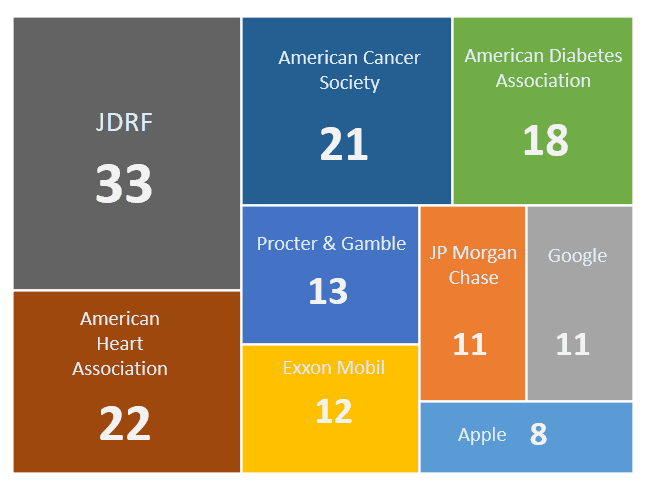A Relative Comparison of Board of Director Membership Size

The Board of Directors has more influence on the performance and direction of an organization than anyone else. This is especially true for T1D non-profits, where the board is responsible for establishing the mission and values, setting the strategic direction, allocating funds, and most importantly exercising accountability to donors.
It is our belief that the board members at the ADA and JDRF have a fiduciary duty to fulfill the priorities of donors and shoulder the ultimate responsibility for keeping the organization on track. This is the group of people who are ultimately responsible for research grant spending descending to historic lows and who are uniquely capable of restoring direct research support to historic norms.
Little has changed in the four years we have been tracking the Board of Directors at the ADA and JDRF:
- Disproportionately large
- Composed mainly of wealthy individual donors
- Selected from an internal population as opposed to a broad base of donors
- Performance accountability of board members remains unclear
- Access to these individuals is extremely limited
We offer four key recommendations about how to improve the performance of the boards, as we have done in the past. These recommendations are informed by best practices from the corporate world but acknowledge the unique circumstances of the non-profit. The recommendations are as follows:
- Hold board members externally accountable. Non-profit board members can only be appointed or removed by fellow board members, which consolidates power in an insulated bubble. Board member election by a broad base of donors would create accountability and ensure alignment with the donor base.
- Decrease the number of members on the non-profit boards. As shown in the opening chart, JDRF has 33 directors and the ADA has 18. In contrast, effective boards in many high-performing organizations have between 8-14 members -- large enough to bring a range of skills and experience to the table but small enough to maintain a meaningful and fully engaged discussion.
- Make transparent annual measures to track cure progress. Clear and transparent executive performance metrics against cure progress must be put in place, enabling the board to hold executives accountable for genuine performance toward the ultimate goal.
- Report in a more frequent, timely, and comprehensive manner. The non-profits only communicate performance in annual reports that come out months after the year-end. More regular, comprehensive reporting on progress would allow donors to stay up to date about progress and make informed giving decisions. Additionally, better communication practices would deepen trust with donors, which would ultimately boost donations to the non-profits.
JDRF INTERNATIONAL BOARD OF DIRECTORS FOR FISCAL YEAR 2017

ADA INTERNATIONAL BOARD OF DIRECTORS FOR FISCAL YEAR 2017

